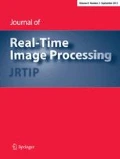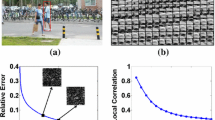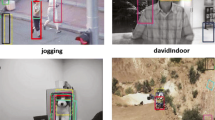Abstract
Video target tracking covers a variety of interdisciplinary subjects such as pattern recognition, image processing, computer graphics and artificial intelligence. In recent years, visual tracking research methods have made significant progress, and scholars have proposed many excellent algorithms. Based on this, this paper uses the basic tracking algorithm and block orthogonal matching pursuit (BOMP) algorithm of image reconstruction, respectively, from the run time, the quality of reconstruction, reconstruction error of the two algorithms to do simulation experiments, and compare their performance, the results show that the BOMP algorithm running time is short, has extensive application, therefore, to determine the BOMP algorithm as a sparse representation model is the core of the method. Then establish the target observation model, introduce the sparse display into the particle filter framework, and update the sparse representation coefficients so that the norm reaches the optimal solution and ensure the accuracy of the tracking target. Finally, through the simulation experiment, the success rate of the target coverage is calculated. The results show that the BOMP algorithm can maintain high tracking accuracy and strong stability in the case of appearance changes caused by illumination changes, partial occlusion and attitude changes.














Similar content being viewed by others
References
Hong Z, Mei X, Prokhorov D, et al.: Tracking via robust multi-task multi-view joint sparse representation. In: IEEE International Conference on Computer Vision, pp. 649–656. Sydney (2013)
He, Z., Yi, S., Cheung, Y.M., et al.: Robust object trackin via key patch sparse representation. IEEE Trans Cybern 47(2), 354–364 (2017)
Bai, T., Li, Y.F., Zhou, X.: Learning local appearances with sparse representation for robust and fast visual tracking. IEEE Trans Cybern 45(4), 663–675 (2015)
Zhang, T., Xu, C., Yang, M.: Robust structural sparse tracking. IEEE Trans Pattern Anal Mach Intell 41(2), 473–486 (2019)
Li, S., Li, K., Fu, Y.: Self-taught low-rank coding for visual learning. IEEE Trans Neural Netw Learn Syst 29(3), 645–656 (2018)
Giryes, R., Elad, M.: Sparsity-based poisson denoising with dictionary learning. IEEE Trans Image Process 23(12), 5057–5069 (2014)
Yang, Y., Hu, W., Zhang, W., et al.: Discriminative reverse sparse tracking via weighted multi-task learning[J]. IEEE Trans Circ Syst VideoTechnol 27(5), 1031–1042 (2017)
Yang, A.Y., Zhou, Z., Balasubramanian, A.G., et al.: Fast -Minimization algorithms for robust face recognition[J]. IEEE Trans Image Process A Publ IEEE Signal Process Soc 22(8), 3234–3246 (2010)
Shi, H., Kai, Cheng, F., et al.: Fast tracking based on local histogram of oriented gradient and dual detection. In: Proceedings of SPIE Automatic Target Recognition, pp. 98–144 (2016)
Yang, A., Li, Y., Liu, C., Li, J., Zhang, Y., Wang, J.: Research on logistics supply chain of iron and steel enterprises based on block chain technology[J]. Fut Generat Comput Syst 101, 635–645 (2019)
Ma, B., Shen, J., Liu, Y., et al.: Visual tracking using strong classifier and structural local sparse descriptors. IEEE Trans Multim 17(10), 1818–1828 (2015)
Zhuang, B., Lu, H., Xiao, Z., et al.: Visual tracking via discriminative sparse similarity map. IEEE Trans Image Process 23(4), 1872 (2014)
Hare, S., Golodetz, S., Saffari, A., et al.: Struck: Structured output tracking with kernels. IEEE Trans Pattern Anal Mach Intell 38(10), 2096–2109 (2015)
He, S., Yang, Q., Lau, R.W.H., et al.: Visual tracking via locality sensitive histograms. Comput Vis Pattern Recogn 2013, 2427–2434 (2013)
Ramirez, I., Sprechmann, P., Sapiro, G.: Classification and clustering via dictionary learning with structured incoherence and shared features. In: IEEE Conference on Computer Vision and Pattern Recognition, pp. 3501–3508. San Francisco (2010)
Yang A, Zhang C, Chen Y, Zhuansun Y, Liu H. Security and privacy of smart home systems based on the internet of things and stereo matching algorithms[J]. IEEE Internet of Things Journal, 2019.
Sui, Y., Tang, Y., Zhang, L., et al.: Visual tracking via subspace learning: a discriminative approach. Int J Comput Vis 126(5), 515–536 (2018)
Shi, J., Ren, X., Dai, G., et al.: A non-convex relaxation approach to sparse dictionary learning. In: IEEE Conference on Computer Vision and Pattern Recognition, pp. 1809–1816. Colorado Springs (2013)
Danelljan, M., Häger, G., Khan, F.S., et al.: Convolutional features for correlation filter based visual tracking. In: IEEE International Conference on Computer Vision Workshop, pp. 621–629. Santiago (2015)
Wei, L., Wang, X., Wu, A., et al.: Robust subspace segmentation by self-representation constrained low-rank representation. Neural Process Lett 48(3), 1671–1691 (2018)
Li, J., Zhang, L., Feng, X., Jia, K., Kong, F.: Feature extraction and area identification of wireless channel in mobile communication[J]. J Internet Technol 20(2), 545–553 (2019)
Yang, M., Zhang, L., Feng, X., et al.: Sparse representation based fisher discrimination dictionary learning for image classification. Int J Comput Vis 109(3), 209–232 (2014)
Author information
Authors and Affiliations
Corresponding author
Additional information
Publisher's Note
Springer Nature remains neutral with regard to jurisdictional claims in published maps and institutional affiliations.
Rights and permissions
About this article
Cite this article
Ma, W., Xu, F. Study on computer vision target tracking algorithm based on sparse representation. J Real-Time Image Proc 18, 407–418 (2021). https://doi.org/10.1007/s11554-020-00999-4
Received:
Accepted:
Published:
Issue Date:
DOI: https://doi.org/10.1007/s11554-020-00999-4




